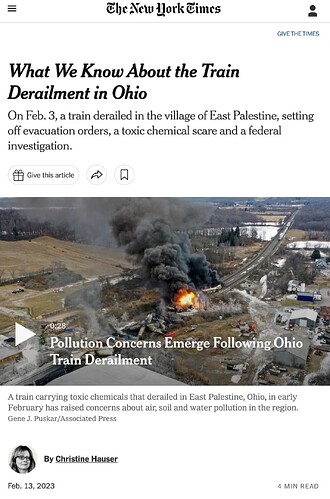-
2月初,一列载有有毒化学品的火车在俄亥俄州东部出轨,导致大火,浓烟席卷东巴勒斯坦镇。这引起了人们对重大爆炸的恐惧,促使当局建立了一个疏散区,并进行了有毒烟雾的控制性释放。
-
东巴勒斯坦的居民担心脱轨和火灾对健康的潜在影响,以及对环境和交通的影响。
-
当局正在继续调查这一事件,并采取措施确保社区的安全,并将任何长期影响降到最低。
-
2月3日晚9点左右,一列火车在俄亥俄州的东巴勒斯坦出轨,该村有大约4700名居民。
-
这列火车由诺福克南方公司运营,载有化学品和可燃材料,其中氯乙烯是一种有毒的可燃气体,是调查人员最关注的。
-
脱轨事件引发了一场大火,浓烟滚滚,直冲云霄,笼罩全镇。俄亥俄州和宾夕法尼亚州边境两边的居民被命令撤离。
-
俄亥俄州的Mike DeWine州长对可能发生的爆炸发出了警报。
-
当地和联邦官员开始调查,涉及国家运输安全委员会和环境保护局。
-
调查正在进行,以确定脱轨的原因和损害的程度。
-
2月5日,诺福克南方公司的一列货运列车在俄亥俄州东巴勒斯坦附近出轨,引发了对空气、土壤和水污染的关注。环保局报告说,包括氯乙烯、丙烯酸丁酯、丙烯酸乙基己酯和乙二醇单丁醚在内的有害物质已经被释放到空气、地表土壤和地表水。环保局的空气监测没有发现东巴勒斯坦及其周边地区的污染物达到 “令人担忧的水平”,尽管居民可能仍然闻到气味。截至2月13日,环保局对大约290个家庭的空气进行了筛查,没有发现氯乙烯或氯化氢。
-
为了防止爆炸,当局在2月6日对五辆火车油罐车的有毒材料进行了控制性释放,内容物被转移到沟渠中并被烧掉。在24个州提供供水服务的美国水务公司报告说,他们在俄亥俄河取水口没有检测到水的任何变化。然而,他们在吉安多特河上安装了一个二级取水口,以备需要备用水源,并加强了他们的处理过程。
-
环保局正在继续监测空气质量,并对东巴勒斯坦及其周边地区的住宅内的空气进行筛选。脱轨事件造成的空气、土壤和水污染的风险仍不确定,对环境的破坏程度也尚待观察。
-
2月6日,由于火车脱轨,东巴勒斯坦的居民被疏散。
-
诺福克南方公司向美国红十字会捐赠了25,000美元,帮助为疏散人员建立庇护所。
-
疏散人员之一的本-拉特纳是1985年唐-德里罗小说《白噪声》改编的2022年电影中的一名临时演员。
-
在空气质量样本测得污染物低于关注水平后,居民于2月8日被允许回家。
-
诺福克南方公司为不想回家的疏散人员提供酒店费用援助。
-
诺福克南方公司正在测试私人水井的水,但鼓励居民使用瓶装水。
-
自脱轨事件发生以来,居民们抱怨头疼和身体不适。
-
两名宾夕法尼亚州的居民已经提起联邦诉讼,迫使诺福克南方公司为这两个州的居民建立健康监测,并为半径30英里范围内的居民支付相关护理费用。
-
社交媒体和新闻报道中出现了动物尸体的图片和关于城镇周围化学气味的报道。
-
环境保护局(EPA)于2月10日通知诺福克南方公司,该公司可能要负责清理现场的相关费用,并没有提供现场何时能恢复正常的细节。
-
国家运输安全委员会(NTSB)仍在调查出轨的原因。
-
俄亥俄州环保局正在进行评估,以制定补救计划。
-
俄亥俄州环保局的媒体关系经理詹姆斯-李表示,最初很难确定释放到空气、水和土壤中的材料的确切数量。
-
紧急情况结束后的评估阶段将有助于确定材料的释放量。
-
In early February, a train carrying toxic chemicals derailed in eastern Ohio, resulting in a fire that swept the town of East Palestine in smoke. This caused fear of a major explosion, prompting the authorities to create an evacuation zone and carry out a controlled release of toxic fumes.
-
Residents in East Palestine are concerned about the potential health effects of the derailment and the fire, as well as the environmental and transportation impacts.
-
The authorities are continuing to investigate the incident and are taking steps to ensure that the community is safe and that any long-term effects are minimized.
-
Around 9 p.m. on Feb. 3, a train derailed in East Palestine, Ohio, a village of about 4,700 residents.
-
The train was operated by Norfolk Southern and had been carrying chemicals and combustible materials, with vinyl chloride, a toxic flammable gas, being of most concern to investigators.
-
A huge fire erupted from the derailment, sending thick billowing smoke into the sky and over the town. Residents on both sides of the Ohio-Pennsylvania border were ordered to evacuate.
-
Gov. Mike DeWine of Ohio raised alarms about a possible explosion.
-
Local and federal officials started an investigation that involved the National Transportation Safety Board and the Environmental Protection Agency.
-
The investigation is ongoing to determine the cause of the derailment and the extent of the damage.
-
The derailment of a Norfolk Southern freight train near East Palestine, Ohio on Feb. 5 sparked concerns about air, soil and water pollution. The EPA reported that hazardous materials, including vinyl chloride, butyl acrylate, ethylhexyl acrylate and ethylene glycol monobutyl ether, had been released to the air, surface soil and surface waters. Air monitoring by the EPA did not detect contaminants at “levels of concern” in and around East Palestine, although residents may still smell odors. The EPA had screened the air inside about 290 homes as of Feb. 13, and had not detected vinyl chloride or hydrogen chloride.
-
To prevent an explosion, the authorities held a controlled release of the toxic materials from five train car tankers on Feb. 6, and the contents were diverted to a trench and burned off. American Water, which provides water services in 24 states, reported that it had not detected any changes in the water at its Ohio River intake site. However, they installed a secondary intake on the Guyandotte River in case an alternate source was needed, and enhanced their treatment processes.
-
The EPA is continuing to monitor the air quality and screen the air inside homes in and around East Palestine. The risk of air, soil and water pollution from the derailment is still uncertain, and the full extent of the damage to the environment is yet to be seen.
-
Residents of East Palestine were evacuated on Feb. 6th due to a train derailment.
-
Norfolk Southern donated $25,000 to the American Red Cross to help set up shelters for evacuees.
-
Ben Ratner, one of the evacuees, was an extra in the 2022 movie adaptation of the 1985 Don DeLillo novel “White Noise."
-
Residents were permitted to return home on Feb. 8th after air quality samples measured contaminants below levels of concern.
-
Norfolk Southern offered evacuees assistance with hotel expenses if they did not want to return home.
-
Norfolk Southern was testing water from private wells, but residents were encouraged to use bottled water.
-
Residents have complained of headaches and feeling sick since the derailment.
-
A federal lawsuit has been filed by two Pennsylvania residents to force Norfolk Southern to set up health monitoring for residents in both states and to pay for related care for those in a 30-mile radius.
-
Social media and news reports have featured images of dead animals and reports of chemical odors around town.
-
The Environmental Protection Agency (EPA) informed Norfolk Southern on Feb. 10 that it may be responsible for costs associated with the clean up of the site and did not provide details of when the site would be returned to normal.
-
The National Transportation Safety Board (NTSB) is still investigating the cause of the derailment.
-
The Ohio EPA is working on an assessment for a remediation plan.
-
James Lee, media relations manager for the EPA in Ohio, stated that initially it is difficult to determine the exact amount of material released into the air, water, and soil.
-
The assessment phase that will occur after the emergency is over will help to determine the amount of material released.
链接:Train Derailment in East Palestine, Ohio: What We Know - The New York Times
